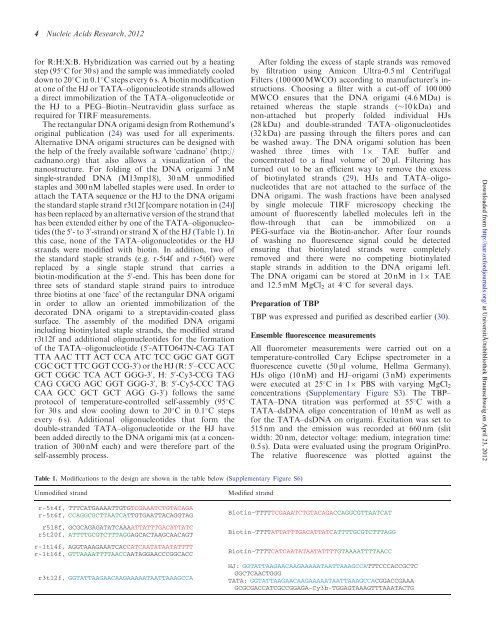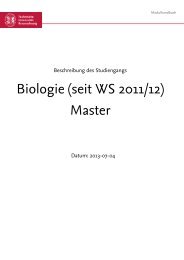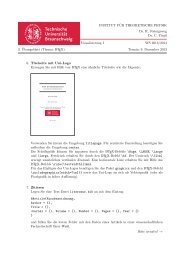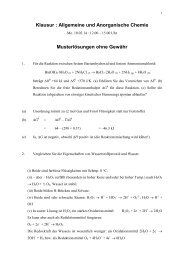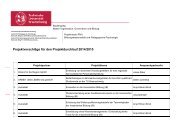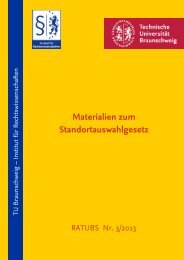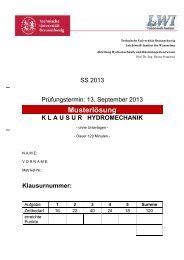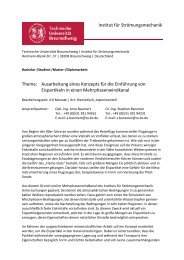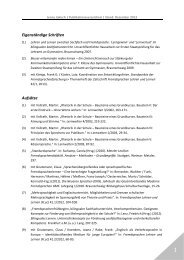L - Technische Universität Braunschweig
L - Technische Universität Braunschweig
L - Technische Universität Braunschweig
You also want an ePaper? Increase the reach of your titles
YUMPU automatically turns print PDFs into web optimized ePapers that Google loves.
4 Nucleic Acids Research, 2012<br />
for R:H:X:B. Hybridization was carried out by a heating<br />
step (95 C for 30 s) and the sample was immediately cooled<br />
down to 20 C in 0.1 C steps every 6 s. A biotin modification<br />
at one of the HJ or TATA–oligonucleotide strands allowed<br />
a direct immobilization of the TATA–oligonucleotide or<br />
the HJ to a PEG–Biotin–Neutravidin glass surface as<br />
required for TIRF measurements.<br />
The rectangular DNA origami design from Rothemund’s<br />
original publication (24) was used for all experiments.<br />
Alternative DNA origami structures can be designed with<br />
the help of the freely available software ‘cadnano’ (http://<br />
cadnano.org) that also allows a visualization of the<br />
nanostructure. For folding of the DNA origami 3 nM<br />
single-stranded DNA (M13mp18), 30 nM unmodified<br />
staples and 300 nM labelled staples were used. In order to<br />
attach the TATA sequence or the HJ to the DNA origami<br />
the standard staple strand r3t12f [compare notation in (24)]<br />
has been replaced by an alternative version of the strand that<br />
has been extended either by one of the TATA–oligonucleotides<br />
(the 5 0 -to3 0 -strand) or strand X of the HJ (Table 1). In<br />
this case, none of the TATA–oligonucleotides or the HJ<br />
strands were modified with biotin. In addition, two of<br />
the standard staple strands (e.g. r-5t4f and r-5t6f) were<br />
replaced by a single staple strand that carries a<br />
biotin-modification at the 5 0 -end. This has been done for<br />
three sets of standard staple strand pairs to introduce<br />
three biotins at one ‘face’ of the rectangular DNA origami<br />
in order to allow an oriented immobilization of the<br />
decorated DNA origami to a streptavidin-coated glass<br />
surface. The assembly of the modified DNA origami<br />
including biotinylated staple strands, the modified strand<br />
r3t12f and additional oligonucleotides for the formation<br />
of the TATA–oligonucleotide (5 0 -ATTO647N-CAG TAT<br />
TTA AAC TTT ACT CCA ATC TCC GGC GAT GGT<br />
CGC GCT TTC GGT CCG-3 0 ) or the HJ (R: 5 0 –CCC ACC<br />
GCT CGGC TCA ACT GGG-3 0 ,H:5 0 -Cy3-CCG TAG<br />
CAG CGCG AGC GGT GGG-3 0 ,B:5 0 -Cy5-CCC TAG<br />
CAA GCC GCT GCT AGG G-3 0 ) follows the same<br />
protocol of temperature-controlled self-assembly (95 C<br />
for 30 s and slow cooling down to 20 C in 0.1 C steps<br />
every 6 s). Additional oligonucleotides that form the<br />
double-stranded TATA–oligonucleotide or the HJ have<br />
been added directly to the DNA origami mix (at a concentration<br />
of 300 nM each) and were therefore part of the<br />
self-assembly process.<br />
After folding the excess of staple strands was removed<br />
by filtration using Amicon Ultra-0.5 ml Centrifugal<br />
Filters (100 000 MWCO) according to manufacturer’s instructions.<br />
Choosing a filter with a cut-off of 100 000<br />
MWCO ensures that the DNA origami (4.6 MDa) is<br />
retained whereas the staple strands (10 kDa) and<br />
non-attached but properly folded individual HJs<br />
(28 kDa) and double-stranded TATA–oligonucleotides<br />
(32 kDa) are passing through the filters pores and can<br />
be washed away. The DNA origami solution has been<br />
washed three times with 1 TAE buffer and<br />
concentrated to a final volume of 20 ml. Filtering has<br />
turned out to be an efficient way to remove the excess<br />
of biotinylated strands (29), HJs and TATA–oligonucleotides<br />
that are not attached to the surface of the<br />
DNA origami. The wash fractions have been analysed<br />
by single molecule TIRF microscopy checking the<br />
amount of fluorescently labelled molecules left in the<br />
flow-through that can be immobilized on a<br />
PEG-surface via the Biotin-anchor. After four rounds<br />
of washing no fluorescence signal could be detected<br />
ensuring that biotinylated strands were completely<br />
removed and there were no competing biotinylated<br />
staple strands in addition to the DNA origami left.<br />
The DNA origami can be stored at 20 nM in 1 TAE<br />
and 12.5 mM MgCl 2 at 4 C for several days.<br />
Preparation of TBP<br />
TBP was expressed and purified as described earlier (30).<br />
Ensemble fluorescence measurements<br />
All fluorometer measurements were carried out on a<br />
temperature-controlled Cary Eclipse spectrometer in a<br />
fluorescence cuvette (50 ml volume, Hellma Germany).<br />
HJs oligo (10 nM) and HJ–origami (3 nM) experiments<br />
were executed at 25 Cin1 PBS with varying MgCl 2<br />
concentrations (Supplementary Figure S3). The TBP–<br />
TATA–DNA titration was performed at 55 C with a<br />
TATA–dsDNA oligo concentration of 10 nM as well as<br />
for the TATA–dsDNA on origami. Excitation was set to<br />
515 nm and the emission was recorded at 660 nm (slit<br />
width: 20 nm, detector voltage: medium, integration time:<br />
0.5 s). Data were evaluated using the program OriginPro.<br />
The relative fluorescence was plotted against the<br />
Downloaded from http://nar.oxfordjournals.org/ at Universitätsbibliothek <strong>Braunschweig</strong> on April 23, 2012<br />
Table 1. Modifications to the design are shown in the table below (Supplementary Figure S6)<br />
Unmodified strand<br />
r-5t4f, TTTCATGAAAATTGTGTCGAAATCTGTACAGA<br />
r-5t6f, CCAGGCGCTTAATCATTGTGAATTACAGGTAG<br />
r518f, GCGCAGAGATATCAAAATTATTTGACATTATC<br />
r5t20f, ATTTTGCGTCTTTAGGAGCACTAAGCAACAGT<br />
r-1t14f, AGGTAAAGAAATCACCATCAATATAATATTTT<br />
r-1t16f, GTTAAAATTTTAACCAATAGGAACCCGGCACC<br />
r3t12f, GGTATTAAGAACAAGAAAAATAATTAAAGCCA<br />
Modified strand<br />
Biotin-TTTTTCGAAATCTGTACAGACCAGGCGTTAATCAT<br />
Biotin-TTTTATTATTTGACATTATCATTTTGCGTCTTTAGG<br />
Biotin-TTTTCATCAATATAATATTTTGTAAAATTTTAACC<br />
HJ: GGTATTAAGAACAAGAAAAATAATTAAAGCCATTTCCCACCGCTC<br />
GGCTCAACTGGG<br />
TATA: GGTATTAAGAACAAGAAAAATAATTAAAGCCACGGACCGAAA<br />
GCGCGACCATCGCCGGAGA-Cy3b-TGGAGTAAAGTTTAAATACTG


